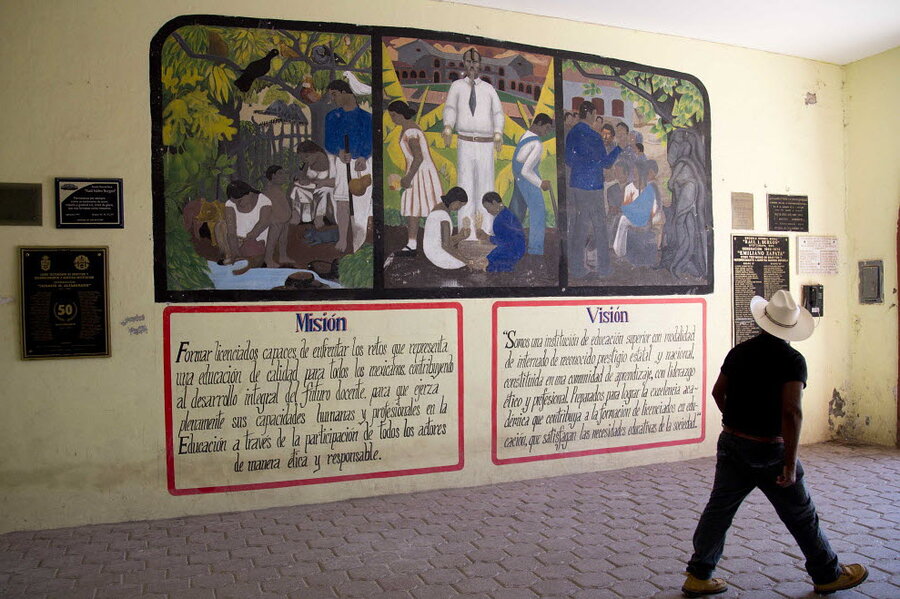At college of missing Mexican students, history of revolutionary zeal
Loading...
| Tixtla, Mexico
With its murals of Che Guevara and Karl Marx and painted slogans about revolution, the rural teachers college in Tixtla, Mexico, seems like a throwback in time.
The college calls itself a cradle of revolutionaries, and students indeed occasionally take to the streets, even hijacking buses and vandalizing buildings.
It was from this shaded campus that 43 students departed on Sept. 26 and never returned, disappearing after witnesses saw them clash with police in the city of Iguala, about a two-hour drive to the north in Guerrero state.
A mass grave was later found in a wooded, mountainous area near Iguala, and 28 bodies have been retrieved. Authorities are still conducting DNA tests to determine if the bodies belong to the missing students. On Thursday, Mexico’s attorney general, Jesus Murillo Karam, said 34 people have been detained in the case and that more mass graves have been identified.
The teachers college here, known as the Raul Isidro Burgos Normal Rural School of Ayotzinapa, is one of 16 institutions around Mexico that arose following Mexico’s revolution nearly a century ago with the aim of training teachers to raise literacy and standards of living among the rural poor.
In more recent decades, the rural teachers colleges became bastions of ardent leftist politics, instilling in students self-reliance, a deep suspicion of the government and a sense that politicians were eager to take away their resources.
Two of the most famous alumni of Ayotzinapa are Lucio Cabanas and Genaro Vazquez, who joined a guerrilla movement in Guerrero state that emerged in the late 1960s. Both died after confrontations with Mexican authorities. An artistic rendering of their faces adorns one side of the basketball court, alongside that of Che Guevara.
The more than 100 students who headed to Iguala Sept. 26 hoped to raise money for a delegation to travel to Mexico City to take part in an annual march that commemorates the Oct. 2, 1968, Tlatelolco massacre, when government security forces opened fire on student protesters, killing perhaps as many as 300.
An impromptu altar now sits in the center of the covered basketball court at this campus in memory of the missing students. Parents of the missing mill about, staffing tables to hand out donated food and tending to visiting activists seeking to take action on behalf of those missing.
“All we want is for them to return the students alive,” says Daniel Tlatempa, a 40-year-old volunteer handing out muffins.
Dread and anger pervade the campus.
“It’s really heavy. You feel the desperation of the parents,” says Jorge Gutierrez, a 20-year-old student who didn’t take part in the Iguala demonstration.
'We just get leftovers'
Students are divided into committees and work units. First-year students tend to fields of corn, sorghum, and vegetables, as well as the livestock and chickens raised to supplement erratic food supplies from the administration.
Students and parents say state politicians regularly short the school of pledged funds.
“If we don’t demand things, nothing comes,” says Juan Carlos Martinez, a 19-year-old student. “We just get leftovers.”
“Compared to other schools, they [politicians] give less here,” says Cornelio Copeno, 47, the father of a student. “There’s never been enough resources, so that’s why this is a school of social struggle.”
Mr. Copeno, a farmer, said he believes the government wants to shut down all the rural teachers colleges, a belief that is widespread among parents.
“The politicians want to make the schools private,” says Sinthia Betancourt, the mother of a student. “I don’t think this is right. The schools are not just for the rich.”
“We represent a big cost to them,” adds Mr. Gutierrez, noting that the schools are largely free to those who enroll. “We are 547 students, and they have to feed us every day. They have to buy us cots and uniforms.”
A goal worth fighting for
The colleges have never quite fulfilled their original dream. In their early years, they trained the sons and daughters of poor farmers to staff rural schools, not only to serve as teachers but also to tend to the sick, oversee the building of water systems, and serve as intermediaries to obtain rural bank loans for cooperatives.
In recent decades, however, the quality of the training has plummeted even as the schools focus largely on education.
“Not all of the professors have the right training,” Gutierrez says. “They are not capable to be teachers.”
Still, the teachers colleges are one of the few avenues that rural poor youth have to prepare for a career that would lift them from poverty. While jobs in schools are no longer guaranteed, once obtained they pay a minimum of about $550 a month, a good salary by Mexican standards.
For some students, it is a goal worth fighting for – literally.
Educated on the revolutionary slogans stenciled on walls across the campus, the “transport committee” routinely organizes students to commandeer public and private buses to take them to marches and rallies, where they seek donations.
“We always do things peacefully – as long as they don’t attack us,” Martinez said, referring to the police. “If they use aggression, we respond with aggression.”
In June 2013, students from the teachers college occupied the City Hall in Iguala in protest of the abduction and killings of three prominent leftist activists. The occupation lasted more than a week, and officials later said damage amounted to more than $300,000.
Even in the wake of the current tragedy, plenty of fight remains in both the students and the parents, who voice determination to keep the school running.
“This school was founded through struggle, and we won’t let it get shut down,” says Rafaela Morales Gallardo, the mother of a student from Guerrero’s coast.







